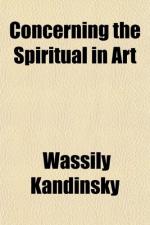The outer task may assume many different shapes; but it will never fail in one of two purposes: (1) Either form aims at so limiting surfaces as to fashion of them some material object; (2) Or form remains abstract, describing only a non-material, spiritual entity. Such non-material entities, with life and value as such, are a circle, a triangle, a rhombus, a trapeze, etc., many of them so complicated as to have no mathematical denomination.
Between these two extremes lie the innumerable forms in which both elements exist; with a preponderance either of the abstract or the material. These intermediate forms are, at present, the store on which the artist has to draw. Purely abstract forms are beyond the reach of the artist at present; they are too indefinite for him. To limit himself to the purely indefinite would be to rob himself of possibilities, to exclude the human element and therefore to weaken his power of expression.
On the other hand, there exists equally no purely material form. A material object cannot be absolutely reproduced. For good or evil, the artist has eyes and hands, which are perhaps more artistic than his intentions and refuse to aim at photography alone. Many genuine artists, who cannot be content with a mere inventory of material objects, seek to express the objects by what was once called “idealization,” then “selection,” and which tomorrow will again be called something different.
[Footnote: The motive of idealization is so to beautify the organic form as to bring out its harmony and rouse poetic feeling. “Selection” aims not so much at beautification as at emphasizing the character of the object, by the omission of non-essentials. The desire of the future will be purely the expression of the inner meaning. The organic form no longer serves as direct object, but as the human words in which a divine message must be written, in order for it to be comprehensible to human minds.]
The impossibility and, in art, the uselessness of attempting to copy an object exactly, the desire to give the object full expression, are the impulses which drive the artist away from “literal” colouring to purely artistic aims. And that brings us to the question of composition. [Footnote: Here Kandinsky means arrangement of the picture.—M.T.H.S.]
Pure artistic composition has two elements:
1. The composition of the whole picture.
2. The creation of the various forms which, by standing in different relationships to each other, decide the composition of the whole. [Footnote: The general composition will naturally include many little compositions which may be antagonistic to each other, though helping—perhaps by their very antagonism—the harmony of the whole. These little compositions have themselves subdivisions of varied inner meanings.] Many objects have to be considered in the light of the whole, and so ordered as to suit this whole. Singly they will have




